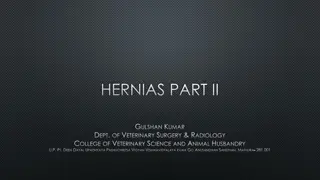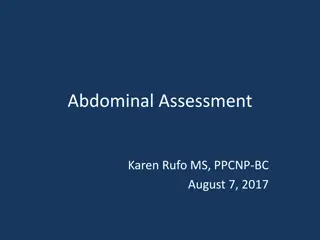Comprehensive Information on Various Types of Hernias and Their Characteristics
A comprehensive overview of different types of hernias including inguinal, femoral, umbilical, hiatal, incisional, epigastric, spigelian, and diaphragmatic hernias. Each type is explained with details on definition, symptoms, causes, complications, prevention, diagnosis, and treatment. The content emphasizes the importance of prompt treatment for hernias to avoid potential risks and complications.
Download Presentation

Please find below an Image/Link to download the presentation.
The content on the website is provided AS IS for your information and personal use only. It may not be sold, licensed, or shared on other websites without obtaining consent from the author.If you encounter any issues during the download, it is possible that the publisher has removed the file from their server.
You are allowed to download the files provided on this website for personal or commercial use, subject to the condition that they are used lawfully. All files are the property of their respective owners.
The content on the website is provided AS IS for your information and personal use only. It may not be sold, licensed, or shared on other websites without obtaining consent from the author.
E N D
Presentation Transcript
StudyMafia.Org Hernia Submitted To: Studymafia.org Studymafia.org Submitted By:
Table Contents Definition Introduction Types of Hernia Symptoms of Hernia Causes of Hernia Complications of Hernia Prevention of Hernia Diagnosis of Hernia Treatment of Hernia Conclusion 2
Definition A hernia happens when an internal organ pushes through a weak spot in your muscle or tissue. 3
Introduction There are several types of hernia that you can experience including, inguinal hernias, femoral hernias, umbilical hernias and hiatal hernias. If you have a hernia, it s important to treat it quickly. A hernia occurs when an internal organ or other body part protrudes through the wall of muscle or tissue that normally contains it. Most hernias occur within the abdominal cavity, between the chest and the hips. 4
Types of Hernia Inguinal hernia: In men, the inguinal canal is a passageway for the spermatic cord and blood vessels leading to the testicles. In women, the inguinal canal contains the round ligament that gives support for the womb. Femoral hernia: Fatty tissue or part of the intestine protrudes into the groin at the top of the inner thigh. Femoral hernias are much less common than inguinal hernias and mainly affect older women. 5
Types of Hernia Umbilical hernia: Fatty tissue or part of the intestine pushes through the abdomen near the navel (belly button). Hiatal (hiatus) hernia: Part of the stomach pushes up into the chest cavity through an opening in the diaphragm (the horizontal sheet of muscle that separates the chest from the abdomen). 6
Types of Hernia Incisional hernia: Tissue protrudes through the site of an abdominal scar from a remote abdominal or pelvic operation. Epigastric hernia: Fatty tissue protrudes through the abdominal area between the navel and lower part of the sternum (breastbone). 7
Types of Hernia Spigelian hernia: The intestine pushes through the abdomen at the side of the abdominal muscle, below the navel. Diaphragmatic hernia: Organs in the abdomen move into the chest through an opening in the diaphragm. 8
Causes of Hernia Inguinal and femoral hernias are due to weakened muscles that may have been present since birth, or are associated with aging and repeated strains on the abdominal and groin areas. Such strain may come from physical exertion, obesity, pregnancy, frequent coughing, or straining on the toilet due to constipation. Adults may get an umbilical hernia by straining the abdominal area, being overweight, having a long- lasting heavy cough or after giving birth. 10
Complications of Hernia Get immediate medical attention if you have: Pain around the hernia that s sudden or severe Nausea and vomiting along with the pain These could be signs that an organ or tissue is dangerously stuck within the torn area or that its blood supply is being cut off (called a strangulated hernia). This is a medical emergency. 11
Complications of Hernia The most common complications of abdominal wall hernias are bowel obstruction secondary to the hernia, strangulation. These complications can often be detected at clinical evaluation. Presenting symptoms may include abdominal distention. incarceration, and pain, vomiting, and 12
Prevention of Hernia Maintain ideal body weight by eating a healthy diet and exercising. Eat enough fruits, vegetables and whole grains to avoid constipation. Use correct form when lifting weights or heavy objects. Avoid lifting anything that is beyond your ability. See a doctor when you are ill with persistent coughs or sneezing. Don t smoke, as the habit can lead to coughing that triggers a hernia. 13
Diagnosis of Hernia It is usually possible to see or feel a bulge in the area where a hernia has occurred by physical exam. As part of a male s typical physical exam for inguinal hernias, the doctor feels the area around the testicles and groin while the patient is asked to cough. In some cases, soft-tissue imaging like a CT scan will accurately diagnose the condition. 14
Treatment of Hernia Obstruction (incarceration): Part of the intestine becomes stuck in the inguinal canal, causing nausea, vomiting, stomach pain, and a painful lump in the groin. Strangulation: Part of the intestine is trapped in a way that cuts off its blood supply. In such cases, emergency surgery (within hours of occurring) is necessary to prevent tissue death. 15
Treatment of Hernia Open Surgery In open surgery, the surgeon cuts through the body where the hernia is located. The bulging parts are put back into place and the tear is stitched. Laparoscopic Surgery Using small incisions through which surgical tools (usually a flexible tube with a camera and light that guides the surgeon), the organs/tissues are moved back to where they belong and the hole is repaired. 16
Conclusion Hernias are quite common, and the surgeries that are often used to treat them are some of the most frequently performed surgeries While there are risks with any surgery, hernia surgery is considered safe and effective. Recovery will depend on your overall health and the type of surgery performed. 17
References Google.com Wikipedia.org Studymafia.org Slidespanda.com
Thanks To StudyMafia.org























